trunk Acura CL 2002 Owner's Manual
[x] Cancel search | Manufacturer: ACURA, Model Year: 2002, Model line: CL, Model: Acura CL 2002Pages: 335
Page 26 of 335

Many parents say they pref er to put
an inf ant or small child in the f ront
passenger seat so they can watch the
child, or because the child requires
attention.
Placing a child in the f ront seat
exposes the child to hazards f rom
the passenger’s f ront airbag, and
paying close attention to a child
distracts the driver f rom the
important tasks of driving, placing
both of you at risk.
If a child requires physical attention
or f requent visual contact, we
strongly recommend that another
adult ride with the child in the back
seat. The back seat is far safer for a
child than the front.
Place the largest child in the f ront
seat, provided the child is large
enough to wear a seat belt
properly (see page ).
Move the vehicle seat as far to the
rear as possible (see page ).
Have the child sit upright and well
backintheseat(seepage ).
Make sure the seat belt is properly
positioned and secured (see page
). Leaving children without
adult supervision is illegal in most
states and Canadian provinces,
and can be very hazardous. For
example, inf ants and small
childrenleftinavehicleonahot
day can die f rom heatstroke. And
children lef t alone with the key in
the ignition can accidentally set
the vehicle in motion, possibly
injuring themselves or others.
Your car has two seating positions in
the back seat where children can be
properly restrained.
If you ever have to carry more than
twochildreninyourcar:
Children who play in cars can
accidentally get trapped inside the
trunk. Teach your children not to
play in or around cars. Know how
to operate the emergency trunk
opener (US models only) and
decide if your children should be
shown how to use this f eature (see
page ).
35
17
15 13
84
CONT INUED
If a Child Requires Close
Attention
If You Must Drive with Several
Children Additional Saf ety Precautions
Protecting Children
Driver and Passenger Saf ety
Do not leave children alone in your
vehicle.
Lock both doors and the trunkwhen your car is not in use.
23
Page 27 of 335
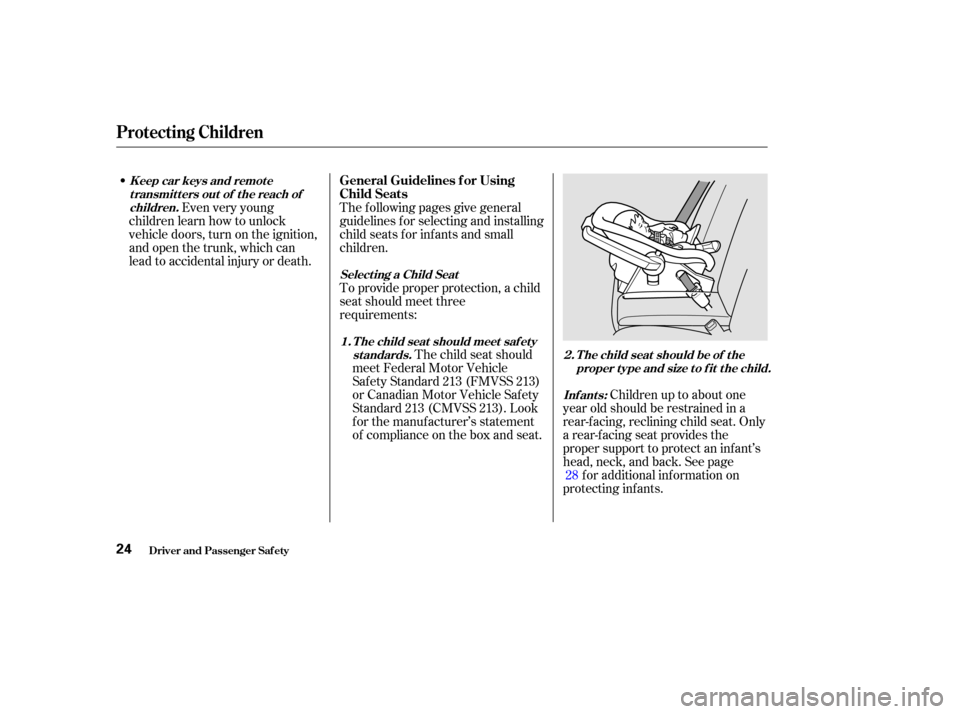
Childrenuptoaboutone
year old should be restrained in a
rear-f acing, reclining child seat. Only
a rear-f acing seat provides the
proper support to protect an inf ant’s
head, neck, and back. See page for additional information on
protecting inf ants.
Even very young
children learn how to unlock
vehicle doors, turn on the ignition,
and open the trunk, which can
lead to accidental injury or death.
The child seat should
meet Federal Motor Vehicle
Saf ety Standard 213 (FMVSS 213)
or Canadian Motor Vehicle Saf ety
Standard 213 (CMVSS 213). Look
for the manufacturer’s statement
of compliance on the box and seat.
The f ollowing pages give general
guidelines f or selecting and installing
child seats f or inf ants and small
children.
To provide proper protection, a child
seat should meet three
requirements:
28
T he child seat should be of theproper t ype and size t o f it t he child.
Inf ant s:
K eep car keys and remot e
transmitters out of the reach ofchildren.
T he child seat should meet saf et yst andards.
Select ing a Child Seat
1. 2.
Protecting Children
Driver and Passenger Saf ety
General Guidelines f or Using
Child Seats
24
Page 52 of 335

High levels of carbon monoxide can
collect rapidly in enclosed areas,
such as a garage. Do not run the
engine with the garage door closed.
Even with the door open, run the
engine only long enough to move the
vehicle out of the garage.If you must sit in your parked car,
even in an unconf ined area, with the
engine running, adjust the climate
control system as f ollows:
Your car’s exhaust contains carbon
monoxide gas. You should have no
problem with carbon monoxide
entering the car in normal driving if
you maintain your car properly.
Have the exhaust system inspected
f or leaks whenever:
The car is raised f or an oil change.
You notice a change in the sound
of the exhaust.
Thecarwasinanaccidentthat
may have damaged the underside. Select the Fresh Air mode.
Select the mode.
Set the f an speed to high.
Set the temperature control to a
comfortable setting.
With the trunk lid open, air f low can
pull exhaust gas into your car’s
interior and create a hazardous
condition. If you must drive with the
trunk lid open, open all the windows
and set the climate control system as
shown below.
1.
2.
3.
4.
Carbon Monoxide Hazard
Driver and Passenger Saf ety49
Carbon monoxide gas is toxic.
Breathing it can cause
unconsciousness and even kill
you.
Avoid any enclosed areas or
activities that expose you to
carbon monoxide.
Page 54 of 335
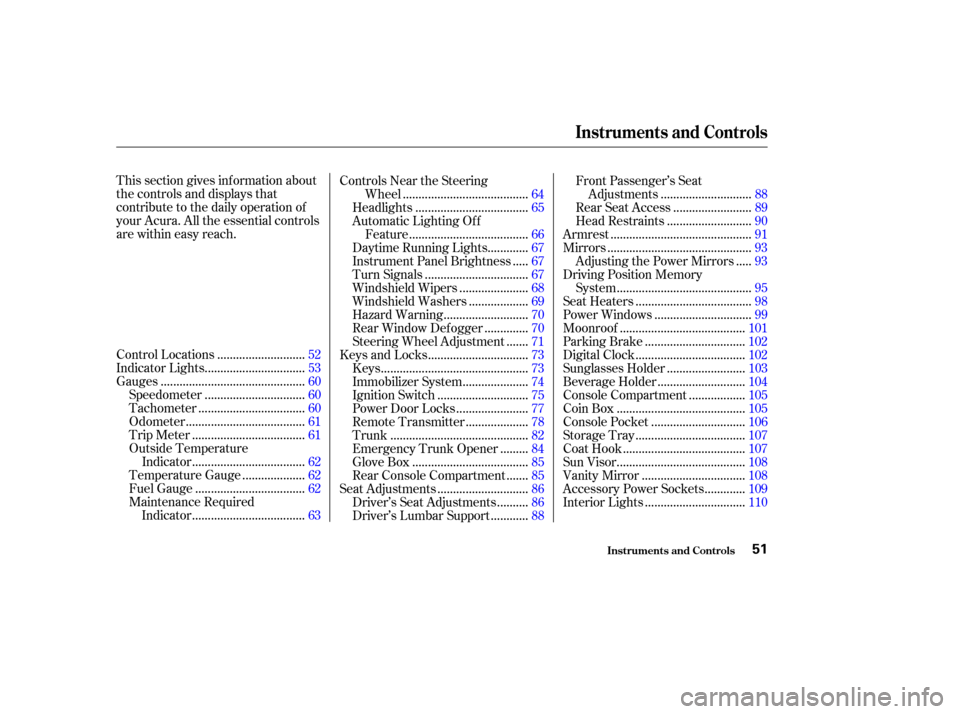
This section gives inf ormation about
the controls and displays that
contribute to the daily operation of
your Acura. All the essential controls
are within easy reach............................
Control Locations .52
...............................
Indicator Lights .53
.............................................
Gauges .60
...............................
Speedometer .60
.................................
Tachometer .60
.....................................
Odometer .61
...................................
Trip Meter .61
Outside Temperature ...................................
Indicator .62
...................
Temperature Gauge . 62
..................................
Fuel Gauge .62
Maintenance Required ...................................
Indicator .63 Controls Near the Steering
.......................................
Wheel .64
...................................
Headlights .65
Automatic Lighting Off .....................................
Feature .66
............
Daytime Running Lights . 67
....
Instrument Panel Brightness . 67
................................
Turn Signals .67
.....................
Windshield Wipers .68
..................
Windshield Washers . 69
..........................
Hazard Warning .70
.............
Rear Window Def ogger . 70
......
Steering Wheel Adjustment . 71
...............................
Keys and Locks .73
..............................................
Keys .73
....................
Immobilizer System . 74
............................
Ignition Switch .75
......................
Power Door Locks .77
...................
Remote Transmitter . 78
...........................................
Trunk .82
........
Emergency Trunk Opener . 84
....................................
Glove Box .85
......
Rear Console Compartment . 85
............................
Seat Adjustments .86
.........
Driver’s Seat Adjustments . 86
...........
Driver’s Lumbar Support . 88Front Passenger’s Seat
............................
Adjustments .88
........................
Rear Seat Access .89
..........................
Head Restraints .90
............................................
Armrest .91
.............................................
Mirrors .93
....
Adjusting the Power Mirrors . 93
Driving Position Memory ..........................................
System .95
....................................
Seat Heaters .98
..............................
Power Windows .99
.......................................
Moonroof .101
...............................
Parking Brake .102
..................................
Digital Clock .102
........................
Sunglasses Holder .103
...........................
Beverage Holder .104
.................
Console Compartment . 105
........................................
Coin Box .105
.............................
Console Pocket .106
..................................
Storage Tray .107
......................................
Coat Hook .107
........................................
Sun Visor .108
................................
Vanity Mirror .108
............
Accessory Power Sockets . 109
...............................
Interior Lights .110
Instruments and Controls
Inst rument s and Cont rols51
Page 61 of 335

This light comes on with the high
beam headlights. See page for
inf ormation on the headlight
controls.
On Canadian models, this indicator
comes on with reduced brightness
when the Daytime Running Lights
(DRL) are on (see page ).
This indicator lights when you turn
the ignition switch to ON (II) with
the headlight switch of f and the
parking brake set. It should go of f if
youturnontheheadlightsorrelease
the parking brake. If it comes on at
any other time, it means there is a
problem with the DRL. There may
also be a problem with the high
beam headlights.
The lef t or right turn signal light
blinks when you signal a lane change
or turn. If the light does not blink or
blinks rapidly, it usually means one
of the turn signal bulbs is burned out
(see page ). Replace the bulb as
soon as possible, since other drivers
cannot see that you are signalling.
WhenyouturnontheHazard
Warning switch, both turn signal
lights blink. All turn signals on the
outside of the car should f lash.
The appropriate light comes on in
this display if the trunk or either
door is not closed tightly with the
ignition switch ON (II). 65
67
257
Canadian models only
High Beam Indicator
‘‘Daytime Running
Lights’’ Indicator
Turn Signal and
Hazard Warning
Indicators
Door and T runk Open Monitor
Indicator L ights
Inst rument s and Cont rols58
Page 76 of 335
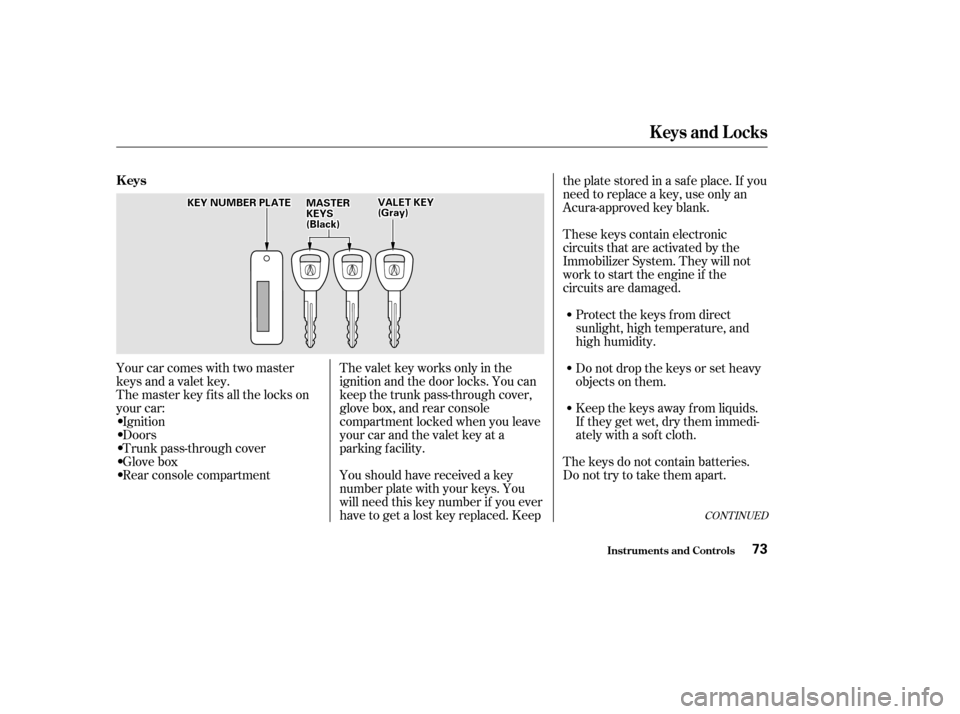
Your car comes with two master
keys and a valet key.
The master key fits all the locks on
your car:
Ignition
Doors
Trunk pass-through cover
Glovebox
Rear console compartmentThe valet key works only in the
ignition and the door locks. You can
keep the trunk pass-through cover,
glove box, and rear console
compartment locked when you leave
your car and the valet key at a
parking f acility.
Youshouldhavereceivedakey
number plate with your keys. You
will need this key number if you ever
have to get a lost key replaced. Keepthe plate stored in a saf e place. If you
need to replace a key, use only an
Acura-approved key blank.
These keys contain electronic
circuits that are activated by the
Immobilizer System. They will not
work to start the engine if the
circuits are damaged.
Protect the keys f rom direct
sunlight, high temperature, and
high humidity.
Donotdropthekeysorsetheavy
objects on them.
Keep the keys away f rom liquids.
If they get wet, dry them immedi-
ately with a soft cloth.
The keys do not contain batteries.
Do not try to take them apart.
CONT INUED
Keys
Keys and Locks
Inst rument s and Cont rols73
V V A
AL
LEE T
T K
KEEY
Y
(
( G
Gr raay y))
M
M
A
AS
STTE
ER
R
K
KE EY
YS S
(
( B
Bl laac ckk) )
K
KE
EY
Y N
NUUMM B
BEER
R P
PL
LAA T
TE
E
Page 82 of 335
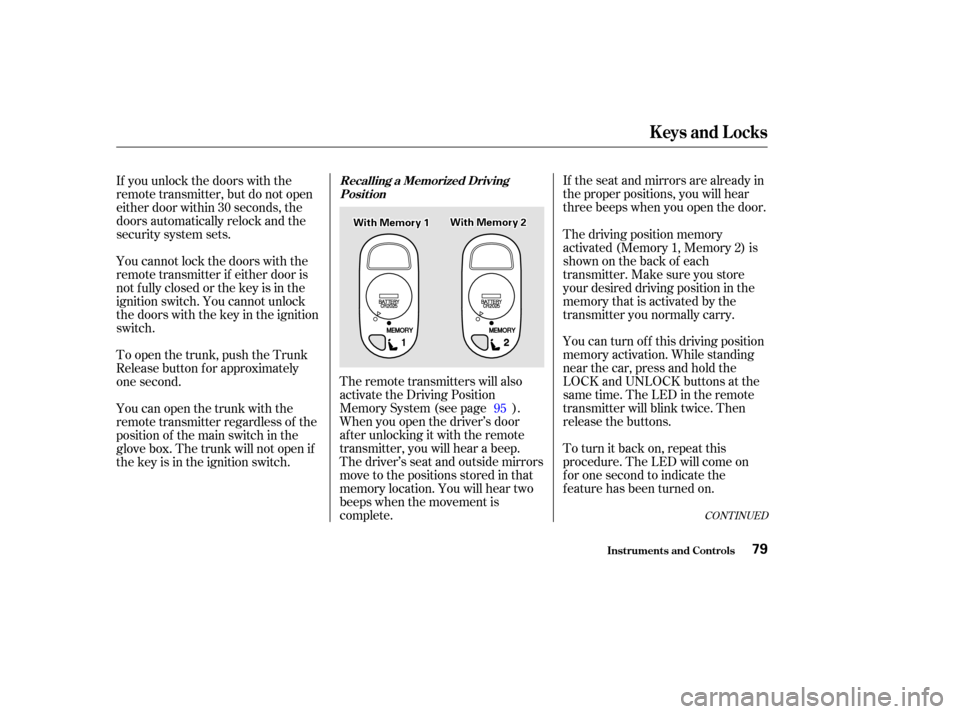
CONT INUED
If the seat and mirrors are already in
the proper positions, you will hear
three beeps when you open the door.
Theremotetransmitterswillalso
activate the Driving Position
Memory System (see page ).
When you open the driver’s door
after unlocking it with the remote
transmitter, you will hear a beep.
The driver’s seat and outside mirrors
move to the positions stored in that
memory location. You will hear two
beeps when the movement is
complete. The driving position memory
activated (Memory 1, Memory 2) is
shownonthebackof each
transmitter. Make sure you store
your desired driving position in the
memory that is activated by the
transmitter you normally carry.
You can turn of f this driving position
memory activation. While standing
near the car, press and hold the
LOCK and UNLOCK buttons at the
same time. The LED in the remote
transmitter will blink twice. Then
release the buttons.
To turn it back on, repeat this
procedure. The LED will come on
f or one second to indicate the
f eature has been turned on.
If you unlock the doors with the
remote transmitter, but do not open
either door within 30 seconds, the
doors automatically relock and the
security system sets.
You cannot lock the doors with the
remote transmitter if either door is
not f ully closed or the key is in the
ignition switch. You cannot unlock
the doors with the key in the ignition
switch.
To open the trunk, push the Trunk
Release button f or approximately
one second.
You can open the trunk with the
remote transmitter regardless of the
position of the main switch in the
glove box. The trunk will not open if
the key is in the ignition switch.
95
Keys and Locks
Inst rument s and Cont rols
Recalling a Memorized Driving
Position
79
W Wi itth h M
M e
emm o
or
ryy 1
1 W
Wi
itth h M
M e
emm o
or
ryy 2
2
Page 85 of 335
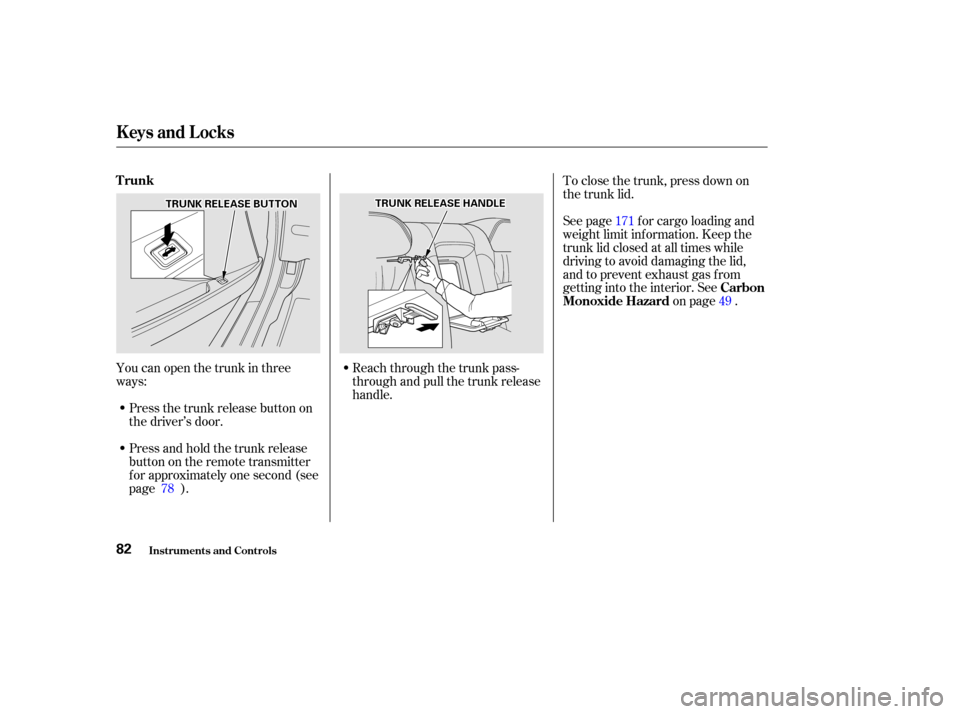
Youcanopenthetrunkinthree
ways:Press the trunk release button on
the driver’s door.
Press and hold the trunk release
button on the remote transmitter
f or approximately one second (see
page ). Reach through the trunk pass-
through and pull the trunk release
handle.To close the trunk, press down on
the trunk lid.
See page f or cargo loading and
weight limit inf ormation. Keep the
trunk lid closed at all times while
driving to avoid damaging the lid,
and to prevent exhaust gas from
getting into the interior. See
on page .
78 49
171
Keys and Locks
Inst rument s and Cont rols
Trunk
Carbon
Monoxide Hazard
82
T T R
RU UN NKK R
REEL
LEE A
A S
SEE B
BUUT TT
TO
ON N T
T
R
RU UN NKK R
REEL
LEE A
A S
SEE H
HA
AN
ND DL
LEE
Page 86 of 335
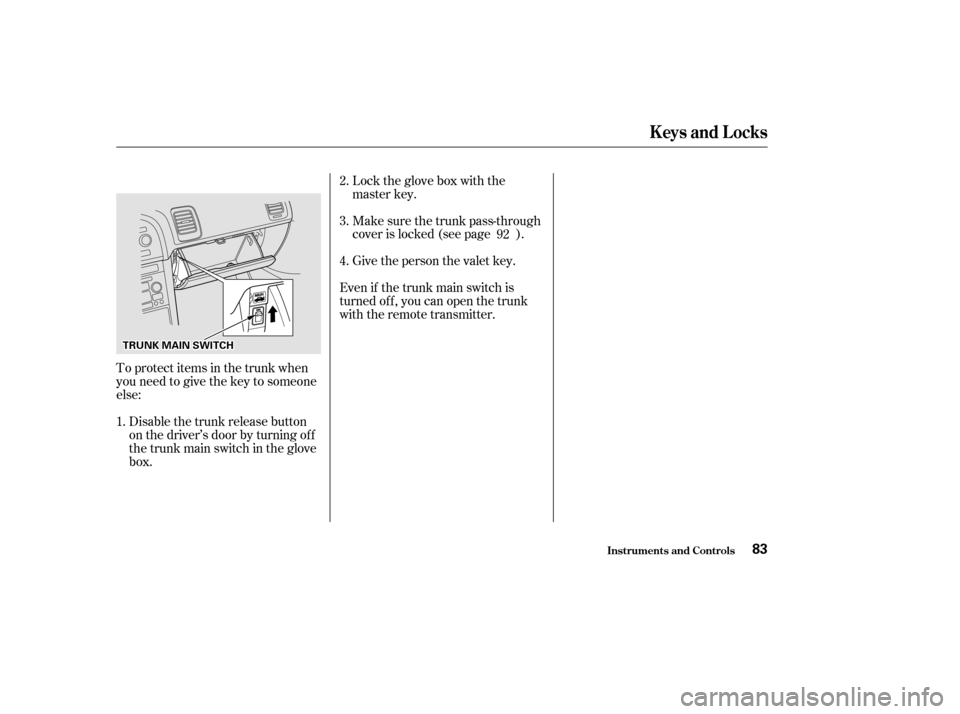
To protect items in the trunk when
you need to give the key to someone
else:Disable the trunk release button
on the driver’s door by turning of f
the trunk main switch in the glove
box. Lock the glove box with the
master key.
Make sure the trunk pass-through
cover is locked (see page ).
Give the person the valet key.
Even if the trunk main switch is
turned of f , you can open the trunk
with the remote transmitter.
1. 2.
3.
4.
92
Keys and Locks
Inst rument s and Cont rols83
T T
R
RU UN NKK M
M A
AI
INN S
SWWI ITT C
CH H
Page 87 of 335
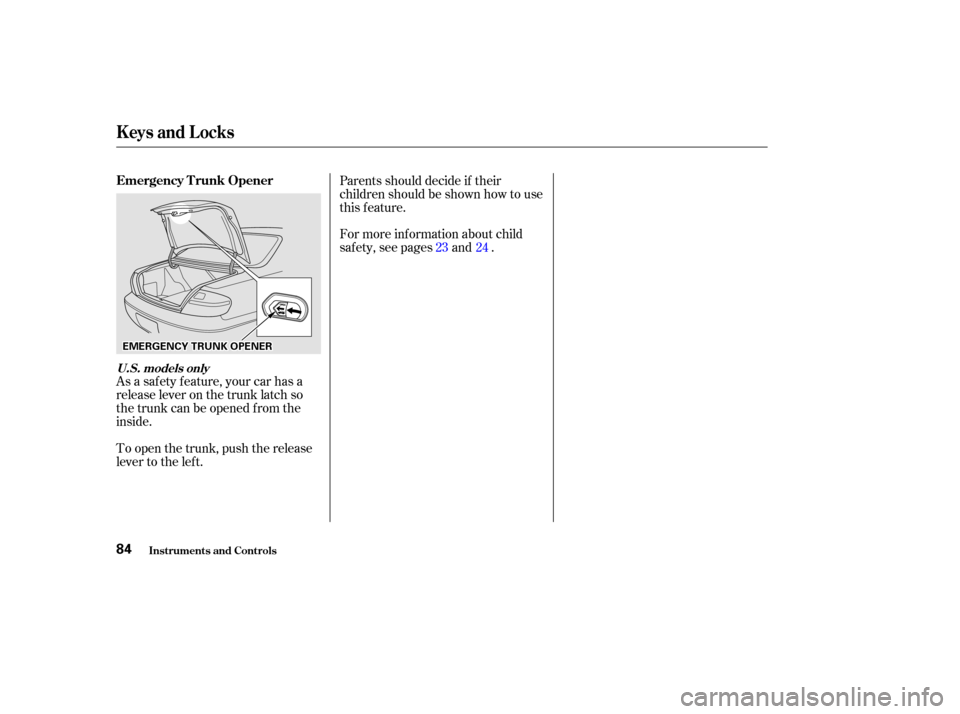
To open the trunk, push the release
lever to the lef t. As a saf ety f eature, your car has a
release lever on the trunk latch so
the trunk can be opened f rom the
inside.Parents should decide if their
children should be shown how to use
this feature.
For more inf ormation about child
saf ety, see pages and .
23 24
Keys and Locks
Inst rument s and Cont rols
Emergency T runk Opener
U.S. models only
84
E EM
M E
ER
RG GE EN
NC CYY T
TR
RU UN NKK O
OPPE
EN
NE ER
R